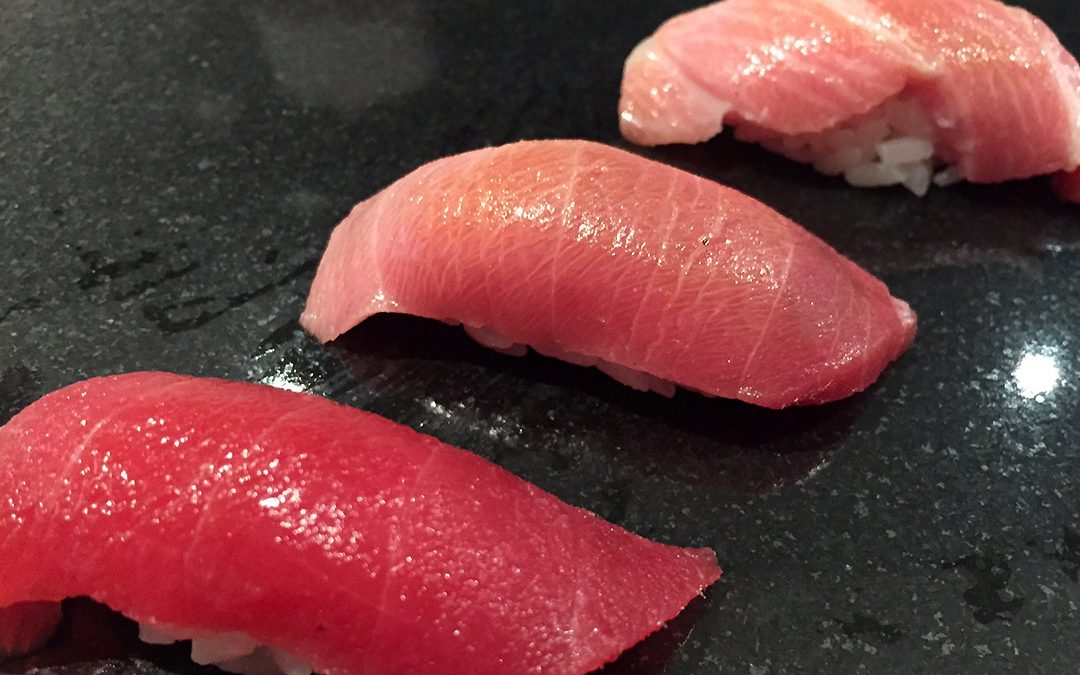Parlare di abbinamento cibo vino è sempre la cosa che preferisco, soprattutto se si sviscera un ingrediente e le sue cotture. Se da un lato l’aspetto didattico del vino non può per forza interessare a tutti, dall’altro conoscere gli abbinamenti più riusciti è una cosa utile e gradita da ogni commensale. Per questo oggi ti parlerò dei vari tagli di tonno e del perché è importante fare delle scelte in base sia alla loro % di grasso, sia in base al tipo di cottura prescelto. La prima cosa che ci tengo ad insegnarti è che per fare l’abbinamento giusto, ancora prima dell’ingrediente, dovresti analizzare il tipo di cottura e soprattutto i condimenti e le salse utilizzate. Tendenzialmente gli ingredienti grassi si prestano meglio di quelli magri ai più svariati metodi di cottura.
Tonno
Il tonno è un pesce predatore che nuota velocemente e per questo ha una forma del corpo idrodinamica. Le sue carni sono molto saporite. Ci sono varie specie di tonno, ma la più utilizzata in Giappone è il Tonno Rosso, che è anche la varietà più pregiata. L’80% del tonno rosso consumanto nel mondo viene consumato proprio in Giappone, tanto che i giapponesi sono costretti anche ad importarlo… proprio dall’Italia! La prima differenza del tonno rosso “a pinna blu” rispetto al comune e poco pregiato tonno “a pinne gialle” sta proprio nella % di grasso: il tonno rosso è globalmente più grasso e calorico rispetto al cugino economico.
Tagli del Tonno

Ventresca
La Ventresca (Toro) è la parte più pregiata del tonno ed è caratterizzata da una marezzatura molto pronunciata che la rende simile alla carne di Kobe. I maestri di sushi la rispettano per la sua purezza e la preparano sia in sashimi, sia in Aburi, ovvero con la cottuara a fiamma con il canello. La percezione della ventresca è di una carne dal gusto avvolgente e burroso, con il grasso che sembra quasi fondersi al contatto con la lingua calda. La salsa di soia è sconsigliata per non coprirne il gusto delicato. Il wasabi è consigliato solo se il contenuto di grasso è davvero molto alto. Il vino italiano da abbinare è bianco, da scegliere tra spumante o fermo. La bollicina è più indicata per pulire la sensazione di grassezza.

Chu-Toro
Il Chu-Toro ha un contenuto di grasso pari a circa il 50% della carne. Perfetto per essere degustata sia come nigiri che come semplice sashimi. Ha un gusto delicato e si scioglie in bocca, senza però essere immediatamente cedevole al palato come il Toro. Il gusto è pronunciato e con note di noci e frutta secca, quasi come un salume, questo perchè sebbene sia una parte grassa, viene comunque irrorata dal sangue. Il Chutoro si presta ad essere degustato in abbinamento ad una bollicina, necessitando di un aiuto per smorzare la nota burrosa della carne. Molto spesso più che nella salsa di soia, la quale rovinerebbe con la sua salinità il sapore, si accompagna al wasabi, che sebbene piccante ha una nota fruttata, ideale al fine di ottenere al palato un contrasto e bilanciamento perfetto.

Akami
Akami è il taglio ottenuto dalla parte più magra del tonno e si riconosce per il suo colore rosso vivo. La poca % di grasso la rende una carne senza la spiccata tendenza dolce delle precedenti, ma asciutta e saporita. Per questo si abbina meglio a un vino rosso giovane. Anche se è il taglio meno pregiato, da molte soddisfazioni anche nel Sashimi.

Quale tipo di sushi di tonno preferisci?
Che vino ci abbini di solito?


